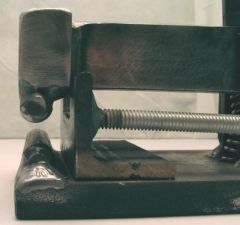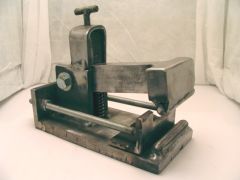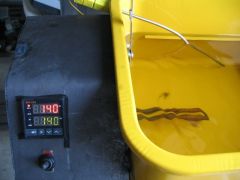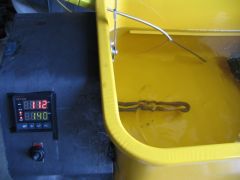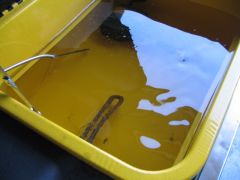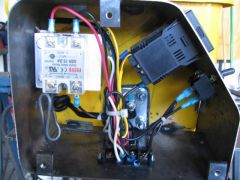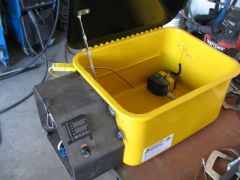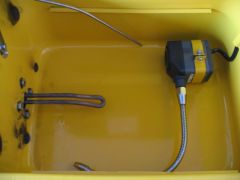-
Posts
76 -
Joined
-
Last visited
Content Type
Profiles
Forums
Articles
Gallery
Downloads
Events
Everything posted by teknition
-
I think I will stick to quench oil :D
-

adjustable blade fullering tool
Images added to a gallery album owned by teknition in Members Gallery
-
From the album: adjustable blade fullering tool
-
From the album: adjustable blade fullering tool
-
Thank you for clearing that up for me Tyler. I guess from what I've recently read, that I should have said the blade was "differentially quenched" or "edge quenched". For some interesting reading on heat treatment of steels, Mr.Cashen as well as Mete over on bladeforums have a pretty vast knowledge on the topic and are freely sharing some great info. Here is a link to just one of many threads on the subject over there. http://216.26.139.58/forums/showthread.php?t=440355
-
Good question Tyler. These are some of the resources I used for learning the heat treat for 1084 (There isn't alot of info on the web about it) Heat treating 1084 Steel Knife Network : Workshop - Heat Treating From what I've read, the steel needs to go from 1500-1550 degrees to below 400 degrees in one second or less and the quench oil temp should be 140-150 degrees F to properly harden the steel I may have used the wrong term when I said "marquenched". What I meant by marquenched is that the blade was not fully submerged in the quench oil but rather it was partially submerged in the quench to leave the ricasso and most of the spine soft while the edge was fully hardened. I believe this is called marquenching? There are so many terms in the heat treating that it is sometimes confusing. I know that a blade being quenched in salt at just above 400 degrees (martensite finish) is referred to as marquenching. There are deffinate advantages to quenching in salt such as a more complete and gentle transformation to martensite and not having to regrind the blade to remove scale. From what I've read, (lots), basically the way you put the blade in the salt (finish) is the way it comes out. More advantages of salt pots are quick and even heating to critical temperature and less warpage because of the even heating of the steel (no burnt tips and decarburization, etc) I am planning on setting up salt tanks to treat the blades I make, I just haven't made it that far yet. I have the digitally controlled forge made already, all I have left is to get a stainless pipe and some salt to be able to do it. The price of stainless pipe is astronomical so it will have to wait for a bit until I can afford it (I have other priorities right now like a good bench to work on instead of a workmate). If you feel like sharing your knowledge of metalurgy and heat treating, I'm more than willing to listen. I by no means know it all or even a quarter of what I would like to learn on the subject.
-
Thanks Tyler. The oil was 140 degrees F
-
Nice job Sam, looks like it will be a great chopper.
-
Thank you all for the kind words, as a new maker your feedback is very encouraging. I always strive to do the best I can as well as gain the skills and knowledge necessary to improve the projects I take on. Like you Ted, I never get tired of looking at the talents of others on this site in the gallery. The displays of skill, creativity, and artistic talent as well as the generous sharing of knowledge on IFI are what makes this site so great.
-
Thanks guys, I appreciate the compliments. Julian, the blade isn't sharpened yet but it does feel nice in the hand. I figured I would wait till I was done playing with it and taking pics to sharpen it so I didn't lose any fingers :D
-
I finished up my second knife tonight. Spec's are: 8" overall, 3-1/4" blade length, 1-1/2" at belly, fullytapered. 3/16" at widest point, flat ground, vine filework. 1084 carbon steel, stock removal, normalized 3X, heated to non magnetic and marquenched in 140 degree quench oil, tempered one hour 2X at 400 degrees. Sanded to 1200 grit and etched in ferric chloride, lightly sanded again with worn 1200 grit and WD40. Handle is African Ironwood with black and white spacers and stainless pins, CA finish, wetsanded to 1200 and buffed. All comments welcome, suggested improvements?
-

Got rid of the stump...
teknition replied to DocsMachine's topic in Blacksmithing, General Discussion
Nice fab job you did there. I like the Idea you had to utilize the normally unused space for a spot to hang your tools. great idea :D -
I dont know anything about coal forges, but it looks like you did a nice job. I hope it works well. Don"t forget to get some pics of the first firing and first forged item.
-
Glad I could help Smitty, if you google "filework" you will find a few tutorials on doing filework. Thanks Skunkriv. The shop is still a work in progress, its filling up fast and I still need benches and a few more tools like a band saw. The kids will be flying the coop soon so all my wood working tools will be moving into the basement and that will free up alot of space in the shop.
-
Nice looking knife Woody, I like the contrast in the handle and the ladder pattern blade
-
Thanks for the compliments guys. Smitty, the filework on the spine was done by laying out even marks at 3/8" along the spine and then using a chainsaw file to make alternating round indents on each side of the blade. Hold the file at about a 45 degree angle to the blade. From there you just blend the round indents so it has smooth flow from one indent to the next. Number 2 should be ready in the next week. Thomas, maybe I will make the railroad shiv in my next batch. lol
-
I finally got my first knife all done. It took a while but I think it was worth it :D
-

digitally controlled heated quench tank
Images added to a gallery album owned by teknition in Members Gallery
-
From the album: digitally controlled heated quench tank
-
From the album: digitally controlled heated quench tank
-
From the album: digitally controlled heated quench tank
-
From the album: digitally controlled heated quench tank
-
From the album: digitally controlled heated quench tank
-
From the album: digitally controlled heated quench tank
-
:o Those are outstanding Rich. I love the file work.

